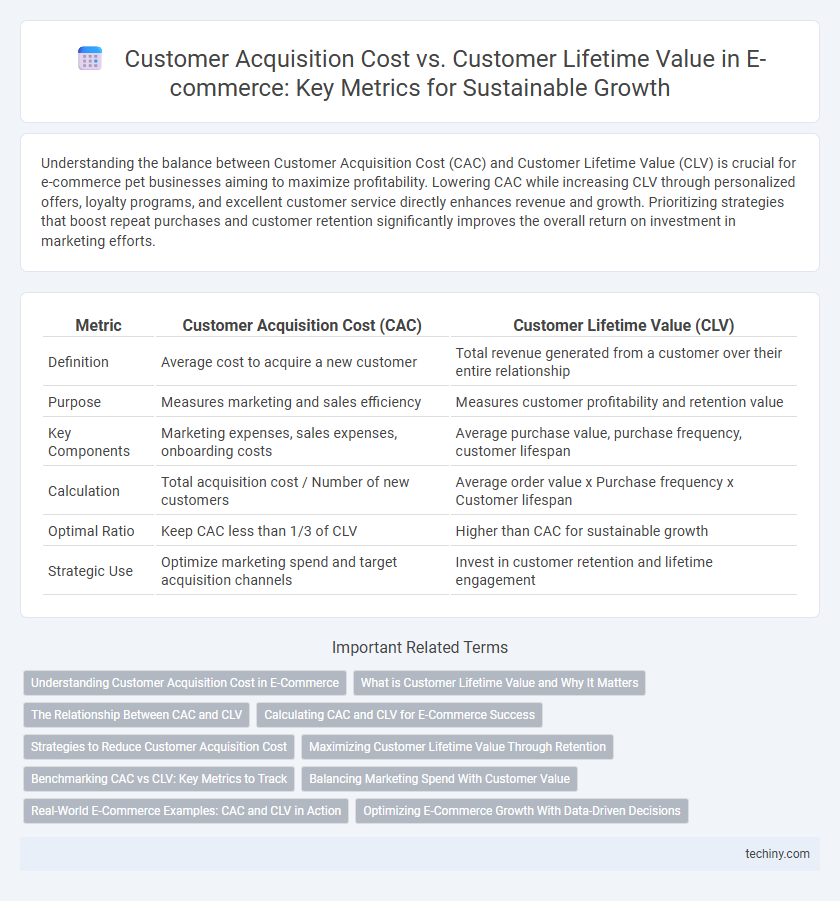Understanding the balance between Customer Acquisition Cost (CAC) and Customer Lifetime Value (CLV) is crucial for e-commerce pet businesses aiming to maximize profitability. Lowering CAC while increasing CLV through personalized offers, loyalty programs, and excellent customer service directly enhances revenue and growth. Prioritizing strategies that boost repeat purchases and customer retention significantly improves the overall return on investment in marketing efforts.
Table of Comparison
| Metric | Customer Acquisition Cost (CAC) | Customer Lifetime Value (CLV) |
|---|---|---|
| Definition | Average cost to acquire a new customer | Total revenue generated from a customer over their entire relationship |
| Purpose | Measures marketing and sales efficiency | Measures customer profitability and retention value |
| Key Components | Marketing expenses, sales expenses, onboarding costs | Average purchase value, purchase frequency, customer lifespan |
| Calculation | Total acquisition cost / Number of new customers | Average order value x Purchase frequency x Customer lifespan |
| Optimal Ratio | Keep CAC less than 1/3 of CLV | Higher than CAC for sustainable growth |
| Strategic Use | Optimize marketing spend and target acquisition channels | Invest in customer retention and lifetime engagement |
Understanding Customer Acquisition Cost in E-Commerce
Customer Acquisition Cost (CAC) in e-commerce measures the total marketing and sales expenses required to attract a new customer, including advertising spend, promotional campaigns, and operational costs. Calculating CAC accurately helps businesses allocate budgets efficiently and optimize their marketing strategies to reduce overspending. Lowering CAC while maintaining or increasing Customer Lifetime Value (CLV) is essential for sustainable growth and profitability in the competitive online retail market.
What is Customer Lifetime Value and Why It Matters
Customer Lifetime Value (CLV) represents the total revenue a business can expect from a single customer throughout their entire relationship. Understanding CLV helps e-commerce companies allocate marketing budgets effectively by comparing it to Customer Acquisition Cost (CAC) to ensure profitability. A higher CLV than CAC indicates sustainable growth and long-term customer loyalty.
The Relationship Between CAC and CLV
Customer Acquisition Cost (CAC) must be significantly lower than Customer Lifetime Value (CLV) to ensure sustainable e-commerce profitability and growth. A favorable CAC to CLV ratio indicates efficient marketing spend and high customer retention, directly impacting revenue and long-term business viability. Monitoring and optimizing the balance between CAC and CLV helps e-commerce companies allocate resources effectively and maximize return on investment.
Calculating CAC and CLV for E-Commerce Success
Calculating Customer Acquisition Cost (CAC) involves dividing total marketing and sales expenses by the number of new customers acquired in a specific period, providing a clear metric to allocate budgets effectively. Customer Lifetime Value (CLV) estimates the total revenue generated from a customer over their entire relationship with the e-commerce store, factoring in purchase frequency, average order value, and retention rates. Comparing CAC and CLV enables businesses to optimize marketing strategies, ensuring customer acquisition efforts are profitable and sustainable for long-term growth.
Strategies to Reduce Customer Acquisition Cost
Reducing Customer Acquisition Cost (CAC) in e-commerce involves optimizing targeted advertising through data-driven audience segmentation and personalized marketing campaigns to increase conversion rates. Leveraging organic channels such as SEO, content marketing, and social media engagement drives sustainable traffic without excessive ad spend. Implementing referral programs and improving website user experience also enhance customer retention and lower overall acquisition expenses, thereby maximizing Customer Lifetime Value (CLV) efficiency.
Maximizing Customer Lifetime Value Through Retention
Maximizing Customer Lifetime Value (CLV) in e-commerce hinges on effective retention strategies that reduce Customer Acquisition Cost (CAC) over time. Implementing personalized marketing, loyalty programs, and seamless post-purchase experiences encourages repeat purchases and increases average order value. Prioritizing customer retention not only lowers marketing expenses but also amplifies revenue by extending the duration and depth of customer relationships.
Benchmarking CAC vs CLV: Key Metrics to Track
Benchmarking Customer Acquisition Cost (CAC) against Customer Lifetime Value (CLV) is crucial for e-commerce profitability, with an optimal CLV to CAC ratio typically ranging from 3:1 to 5:1, indicating sustainable growth. Key metrics to track include CAC payback period, which measures how quickly acquisition costs are recouped, and retention rate, directly impacting CLV by extending the revenue generated per customer. Monitoring these metrics enables precise optimization of marketing spend and customer retention strategies, driving long-term revenue and reducing churn.
Balancing Marketing Spend With Customer Value
Customer Acquisition Cost (CAC) represents the total marketing and sales expenses to acquire one customer, while Customer Lifetime Value (CLV) estimates the revenue a customer generates over their entire relationship with a brand. Balancing CAC with CLV is crucial for sustainable growth, ensuring marketing spend drives profitable customer relationships rather than short-term acquisition. E-commerce businesses optimize budgets by analyzing conversion rates, retention metrics, and average order value to maximize CLV and maintain a healthy CAC-to-CLV ratio.
Real-World E-Commerce Examples: CAC and CLV in Action
E-commerce giants like Amazon report CAC as low as $30 due to efficient targeting while achieving CLV exceeding $1,000 through repeat purchases and upselling. Subscription-based platforms like Shopify calculate CAC around $150 but attain CLV values surpassing $1,200 by fostering long-term merchant relationships. These examples illustrate that optimizing CAC and maximizing CLV are critical for sustainable growth, with data-driven marketing and personalized customer experiences driving higher profitability.
Optimizing E-Commerce Growth With Data-Driven Decisions
Customer Acquisition Cost (CAC) and Customer Lifetime Value (CLV) are pivotal metrics in optimizing e-commerce growth through data-driven decisions. Lowering CAC while increasing CLV ensures sustainable revenue, guiding budget allocation for marketing and customer retention strategies. Utilizing predictive analytics and customer segmentation enhances the precision of these metrics, driving higher profitability and long-term business scalability.
Customer Acquisition Cost vs Customer Lifetime Value Infographic

 techiny.com
techiny.com